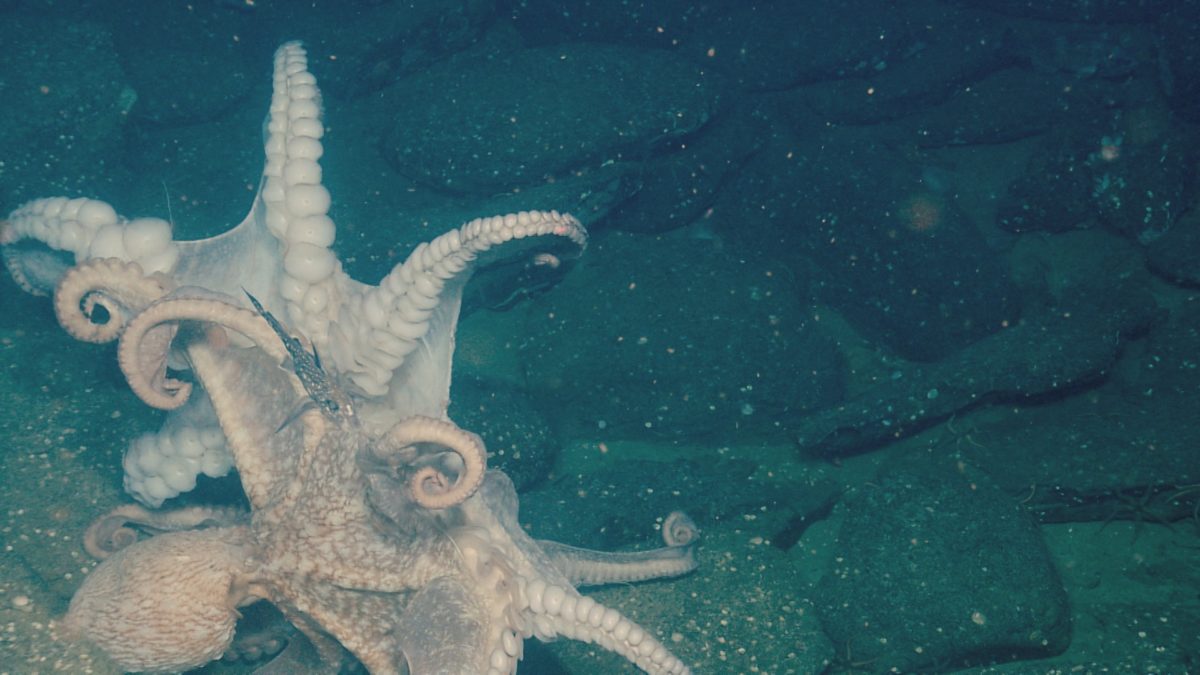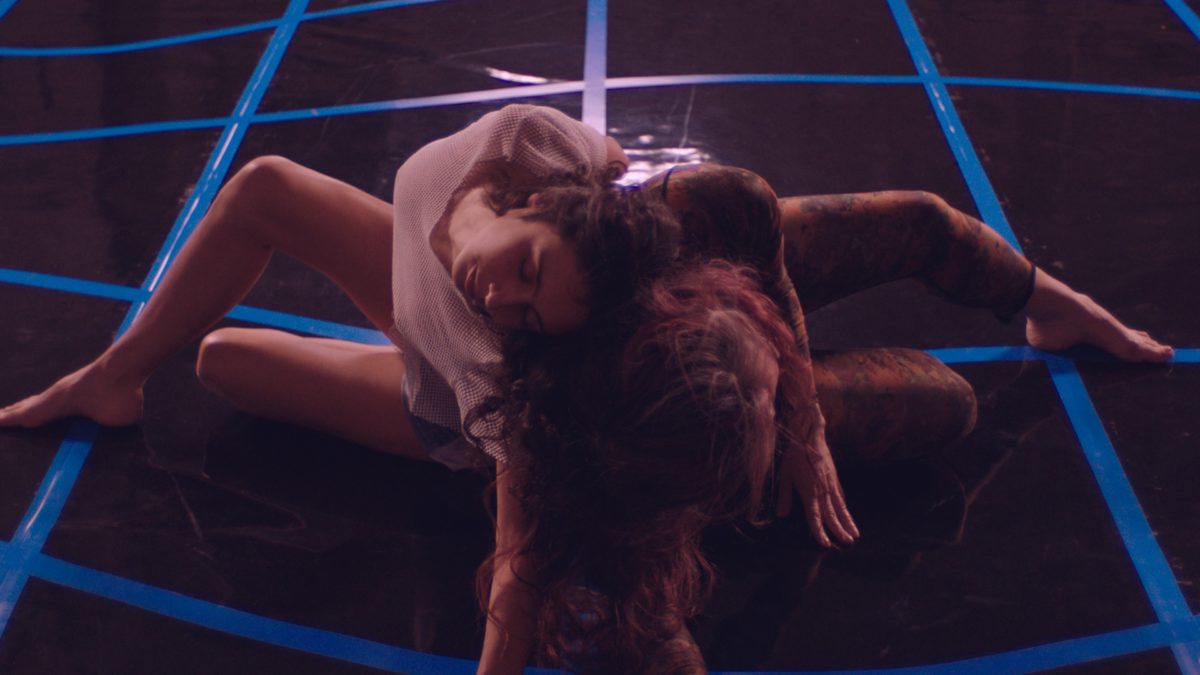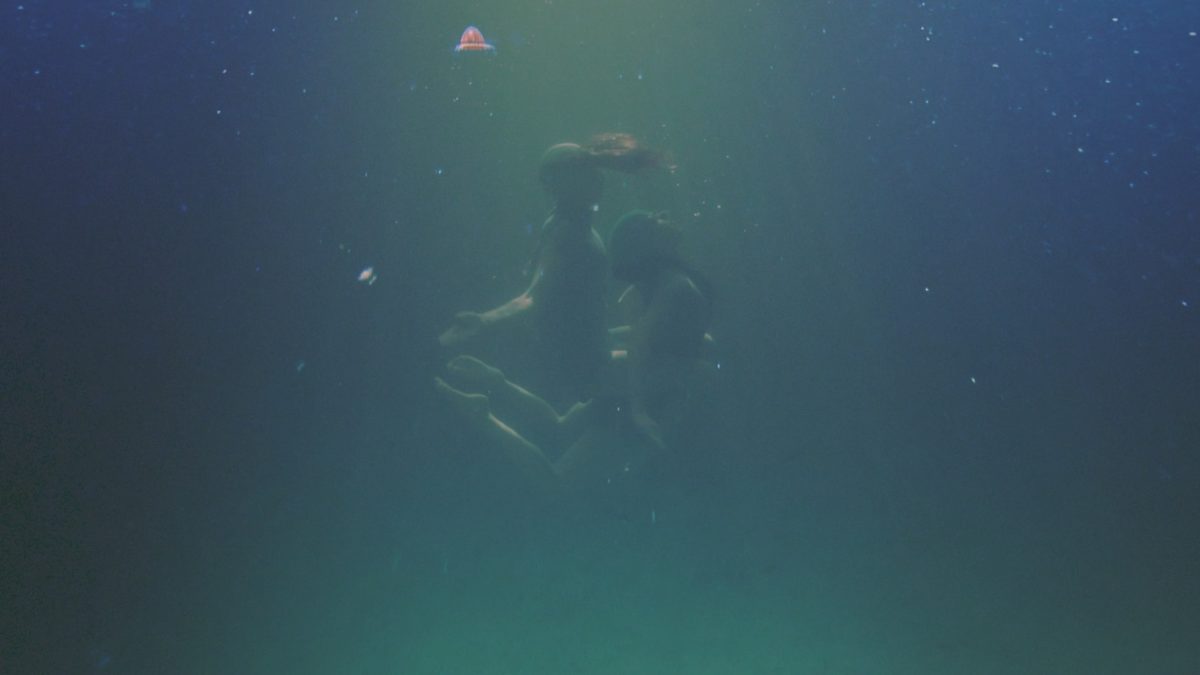The video opens under an expanse of murky green water, as two swimmers clasp each other and slowly pinwheel in place to the somber notes of a piano sonata. A voiceover says, “The world record for human breath-hold underwater is 11 minutes and 54 seconds.”
Cut to a number of young people slowly writhing together on the floor without touching. Then a guitar picks out a flamenco-like melody. A title card reads: AGENTS OF OUR OWN EVOLUTION.
So begins Your Urge to Breathe Is a Lie (2019) by Miriam Simun, who graduated with a Master of Science in Media Arts and Sciences from the MIT Media Lab in 2018. The video manifesto, which proposes the cephalopod (such as a squid or octopus) instead of the machine as a model for a transhumanist future, has been shown this winter in Moscow at the Ground Solyanka Gallery as part of Never the Same Color, a festival of time-based visual art. In 2019, Your Urge to Breathe was featured in the 45th National Salon at The Bogotá Museum of Modern Art, and in the first months of 2020 it was presented in the exhibition Tomorrow Never Knows at the Headland Center for the Arts in San Francisco.
“This is the video component of the work I developed at the Media Lab, I Want to Become a Cephalopod,” says Simun. Together, we practice invoking the octopus as a model, a new way of sensing and being in the world.”
Showing the video in different cities around the world, Simun has been surprised how much people connect with it immediately. “I have to make less of a case for why we might want to go the wet cephalodian route than I thought. The response varies less by geography and more by the individual’s own relationship to the sea, to their body, to their openness to embrace the unknown.”
Intense Immersion
The project came out of what Sumin describes as her intense immersion in the Media Lab, where she was in the Design Fiction Group. The first audience for whom she developed the training was “really specific: engineers.”
It was Sputniko!, director of the Design Fiction group, who invited Simun to the Media Lab. A British/Japanese artist, she creates machines, robotics, music, and video that explore issues surrounding technology and pop culture. “Sputniko! is really inspiring in her ability to cross contexts and audiences,” says Simun. “Her work moves fluidly across art, tech, design, political engagement and fashion worlds.” Sputniko!’s first caused ripples in the contemporary art scene in 2010 with Menstruation Machine—Takashi’s Take, a device that simulates the bleeding and pain so that men may understand the experience.
“It was a great learning experience to watch her navigate these fields successfully,” says Simun. “Design Fiction was a really important group inside the Media Lab, asking questions about the social and political implications of new technologies being developed there.”
Simun recalls how Your Urge to Breathe Is a Lie began as a response to the global rise in sea level and increasing intensity of flooding. She wondered how there might be a different response, “rather than just building sea walls—walls against the sea.” Instead of trying to compulsively control nature, which has brought humankind to the brink of ecological disaster, Simun explored how we “might adapt ourselves to live in this changed nature: to live with and even under the sea.”

Diving Deep Into Research
Originally she considered technology such as implants, prosthetics, and inducing genetic mutations. But then she took classes at MIT in free diving, which is diving without an air supply. “It was really incredible. Free diving was some of the most intense learning that happened for me at MIT. I had been reading and researching a lot, but it was through my body—in a sensorial, corporeal way—that I came to understand something new, something more.”
In a few sessions her ability to hold her breath underwater went from 20 seconds to 2.5 minutes. “I still remember when I was face down in the pool, my trainer’s hand resting gently on my back, everything in me wanting to take a breath, and her calm voice repeating over and over, ‘Your urge to breathe is a lie.'”
In developing her project, Simun applied her training in social science at the London School of Economics. Her process is intensely based in research. Yet at times she feels like “an ethnographer gone rogue” because she breaks lots of rules on objective data collection. “What happens when all the elements we’ve been trained to think of as obstacles—poetics, noise, irrationality and the sensorial—enter the picture?”
The Real Power in the Story
But long before MIT, growing up in the 1980s, Simun reveals that Disney’s The Little Mermaid was a big presence in her life, as it was in the culture. She recently rewatched the film and was shocked to learn that Ariel agrees to give up her voice to be with the man she loves. “Give me Ursula any day,” says Simun. To her, Ursula is the powerful creature in the story (a Cecalia,half human, half octopus), who is supposedly evil but definitely strong.
“And so I was drawn to this myth of Ursula as a model for some future human being. From there I started learning about cephalopods, and how their very biology breaks the Cartesian divide. Their neurons are spread throughout the body, so it’s impossible to distinguish brain from body. And the problems that arise from this body/mind duality, this fallacy, has been at the center of my work for a decade. And, well, down the rabbit hole I went.”
In the video, a cluster of swimmers underwater forms the shape of an octopus, grasping each other’s elbows, their legs undulating in sync as the piano crescendos into dramatic chords to herald a possible future.
Written by Gary Duehr



